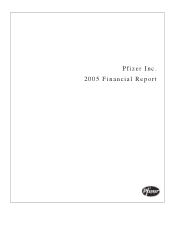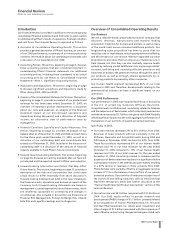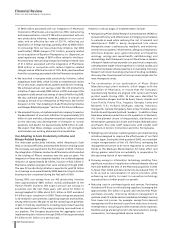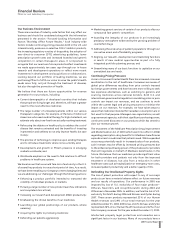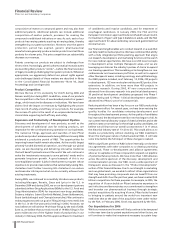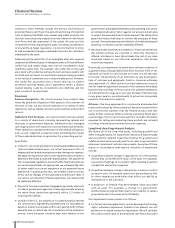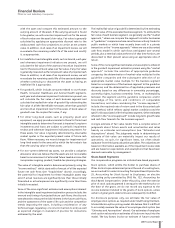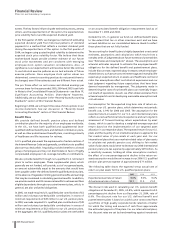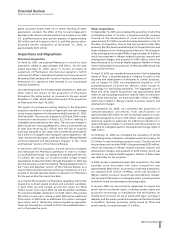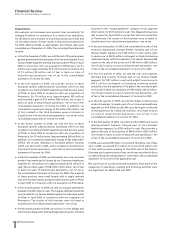Pfizer 2005 Annual Report Download - page 7
Download and view the complete annual report
Please find page 7 of the 2005 Pfizer annual report below. You can navigate through the pages in the report by either clicking on the pages listed below, or by using the keyword search tool below to find specific information within the annual report.
62005 Financial Report
Financial Review
Pfizer Inc and Subsidiary Companies
method or other methods include: the amount and timing of
projected future cash flows; the amount and timing of projected
costs to develop the IPR&D into commercially viable products; the
discount rate selected to measure the risks inherent in the future
cash flows; and the assessment of the asset’s life cycle and the
competitive trends impacting the asset, including consideration
of any technical, legal, regulatory, or economic barriers to entry,
as well as expected changes in standards of practice for indications
addressed by the asset.
Determining the useful life of an intangible asset also requires
judgment as different types of intangible assets will have different
useful lives and certain assets may even be considered to have
indefinite useful lives. For example, the useful life of the right
associated with a pharmaceutical product’s exclusive patent will
be finite and will result in amortization expense being recorded
in our results of operations over a determinable period. However,
the useful life associated with a brand that has no patent
protection but that retains, and is expected to retain, a distinct
market identity could be considered to be indefinite and the
asset would not be amortized.
Revenues
Revenue Recognition—We record revenue from product sales
when the goods are shipped and title passes to the customer. At
the time of sale, we also record estimates for a variety of sales
deductions, such as rebates, discounts and incentives, and product
returns.
Deductions from Revenues—Our gross product sales are subject
to a variety of deductions, primarily representing rebates and
discounts to government agencies, wholesalers and managed
care organizations with respect to our pharmaceutical products.
These deductions represent estimates of the related obligations
and, as such, judgment is required when estimating the impact
of these sales deductions on gross sales for a reporting period.
Specifically:
•In the U.S., we record provisions for pharmaceutical Medicaid and
contract rebates based upon our actual experience ratio of
rebates paid and actual prescriptions written during prior quarters.
We apply the experience ratio to the respective period’s sales to
determine the rebate accrual and related expense. This experience
ratio is evaluated regularly to ensure that the historical trends are
as current as practicable. As appropriate, we will adjust the ratio
to better match our current experience or our expected future
experience. In assessing this ratio, we consider current contract
terms, such as changes in formulary status and discount rates. If
our ratio is not indicative of future experience, our results could
be materially affected.
•Provisions for pharmaceutical chargebacks (primarily discounts
to federal government agencies) closely approximate actual as
we settle these deductions generally within 2-3 weeks of
incurring the liability.
•Outside of the U.S., the majority of our pharmaceutical rebates
are contractual or legislatively-mandated and our estimates are
based on actual invoiced sales within each period; both of these
elements help to reduce the risk of variations in the estimation
process. Some European countries base their rebates on the
government’s unbudgeted pharmaceutical spending and we use
an estimated allocation factor against our actual invoiced sales
to project the expected level of reimbursement. We obtain third
party information that helps us monitor the adequacy of these
accruals. If our estimates are not indicative of actual unbudgeted
spending, our results could be materially affected.
•We record sales incentives as a reduction of revenues at the time
the related revenues are recorded or when the incentive is
offered, whichever is later. We estimate the cost of our sales
incentives based on our historical experience with similar
incentives programs.
Historically, our adjustments to actual have not been material; on
a quarterly basis, they generally have been less than 0.5% of net
sales and can result in a net increase to income or a net decrease
to income. The sensitivity of our estimates can vary by program,
type of customer and geographic location. However, estimates
associated with U.S. Medicaid and contract rebates are most at-
risk for material adjustment because of the extensive time delay
between the recording of the accrual and its ultimate settlement,
an interval that can range up to one year. Because of this time lag,
in any given quarter, our adjustments to actual can incorporate
revisions of several prior quarters.
Alliances—We have agreements to co-promote pharmaceutical
products discovered by other companies. Revenue is earned when
our co-promotion partners ship the related product and title
passes to their customer. Alliance revenue is primarily based upon
a percentage of our co-promotion partners’ net sales. Generally,
expenses for selling and marketing these products are included
in Selling, informational and administrative expenses.
Long-lived Asset Impairment Analysis
We review all of our long-lived assets, including goodwill and
other intangible assets, for impairment indicators at least annually
and we perform detailed impairment testing for goodwill and
indefinite-lived assets annually and for all other long-lived assets
whenever impairment indicators are present. Examples of those
events or circumstances that may be indicative of impairment
include:
•A significant adverse change in legal factors or in the business
climate that could affect the value of the asset. For example,
a successful challenge of our patent rights resulting in generic
competition earlier than expected.
•A significant adverse change in the extent or manner in which
an asset is used. For example, restrictions imposed by the FDA
or other regulatory authorities that affect our ability to
manufacture or sell a product.
•A projection or forecast that demonstrates losses associated
with an asset. For example, a change in a government
reimbursement program that results in an inability to sustain
projected product revenues and profitability.
Our impairment review process is as follows:
•For finite-lived intangible assets, such as developed technology
rights, whenever impairment indicators are present, we will
perform an in-depth review for impairment. We will calculate
the undiscounted value of the projected cash flows associated

